Author Archive
Posted on: October 30th, 2013 by Waterloo Region Crime Prevention Council
Thanks to the Waterloo Region Crime Prevention Council for their 2012 report A Snapshot in Time: The Root Causes of Crime in Waterloo Region. The report has been a conversation starter for important dialogue in our community. It shines a spotlight on the root causes of crime locally, and uses calls to our Centre’s 24 Hour Crisis and Support Line as a data point related to local sexualized crimes.
We know that securing data about the prevalence of sexual violence can be challenging; sexual assault is the most under-reported violent crime in Canada. In 2012 the Waterloo Regional Police Service received 558 sexual assault reports. While that number itself is alarming, we only begin to understand the magnitude of sexualized crimes in our community when we consider that less than 10% of sexual assaults are reported to police nationally. Therefore, pulling data from a number of sources enhances our understanding of this complex issue.
Over the years, our crisis call numbers have fluctuated. In the last decade, there’s been a trend towards a moderate decline in the number of calls received, but the overall demand for our services has increased significantly. The explanation for this is simple; historically we provided more basic information related to services and supports on our crisis line. With much of that information now readily available online, the calls we most often receive today are supportive in nature or focused on crisis intervention.
With new ways of communicating emerging, our Centre has begun to explore the option of incorporating live online support into our crisis and support services.
Who else is involved in addressing this issue?
Awareness of the prevalence and impact of sexual violence has begun to increase regionally, thanks to the commitment of community partners to work in a spirit of collaboration.
In 2007, our community began to mobilize on this issue. A number of service providers formed a network which evolved into the Sexual Assault Response Team of Waterloo Region (SART). SART is now a community coordinating committee made up of 18 partner agencies from the criminal justice sector, the health sector, and the social services sector.
In 2012, SART launched a community protocol for responding to sexual assault in our region. The first such protocol of its kind in Waterloo Region, its purpose is to give service providers a broader foundation for the work they do. The protocol establishes a common understanding and framework for the provision of services to survivors of sexual violence, enabling greater coordination and collaboration between community partners.
What should be done?
Sexual violence impacts people of every age and cultural background, and has devastating impacts on individuals, families and communities. Every survivor, regardless of gender, deserves access to specialized support services in our community to promote healing.
As a region and more broadly, we need to balance our investment in support services for survivors of sexual violence and with public education campaigns aimed at prevention. We have consistently seen that early-intervention and prevention are necessary and cost effective.
It is important to understand, however, that sexual violence is primarily perpetrated by men, against women, children, and trans people.
According to a 2006 Statistics Canada report, more than one in three women will experience some form of sexual assault in her adult lifetime (p24). Over 93% of reported adult sexual assault victims are female, while 97% of those accused are male (p37).
As such, we need to consider social constructions of gender when looking at the prevention of sexualized crimes. Sexual violence is about power and control, not sexual desire. It is about aggressively dominating someone else.
This knowledge was the impetus behind the creation our Male Allies Against Sexual Violence (MAASV) program in 2008. MAASV is a unique public education program focused on working with men in positions to influence male youth (such as coaches, faith leaders, teachers, and fathers). The program explores how popular conceptions of masculinity can limit men’s freedoms and harm others. MAASV encourages young men to treat women with fairness, equality and respect and to stand up and speak out on gendered violence. (More information on MAASV can be found here: www.MaleAllies.org)
Sexual violence is pervasive, but it’s not inevitable. Through public education, social change is possible. A better future exists for our daughters and our sons.
 Author: Sara Casselman is the Public Relations & Operations Manager at the Sexual Assault Support Centre of Waterloo Region. In the anti-violence against women sector for more than a decade, Sara has been recognized provincially as a Leading Women, Building Communities Award Recipient (2011) and was featured in The Record’s 40 under 40 (2012).
Author: Sara Casselman is the Public Relations & Operations Manager at the Sexual Assault Support Centre of Waterloo Region. In the anti-violence against women sector for more than a decade, Sara has been recognized provincially as a Leading Women, Building Communities Award Recipient (2011) and was featured in The Record’s 40 under 40 (2012).
Posted on: October 30th, 2013 by Waterloo Region Crime Prevention Council
Only one in eight sexual assaults in Canada is reported to police. The Sexual Assault Support Centre of Waterloo Region calls for service provides an additional data point to examine sexual assault rates in Waterloo Region. However, this number should be viewed with caution as it fluctuates based on promotion of the crisis line and provides only total number of calls.
The Statistics
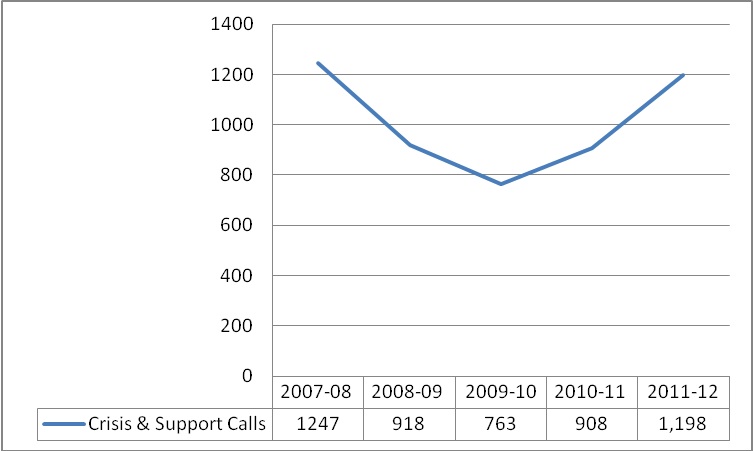
Data Source: Sexual Assault Support Centre of Waterloo Region, Annual Report
Story Behind the Numbers
The Sexual Assault Support Centre of Waterloo Region calls for service have varied considerably since 2007. In the past year there has not been a noticeable increase in the number of calls to the crisis line. In 2012 there was no wait list for men but the wait list for counselling services for women reached an all time high of 40 despite an additional part time counsellor and reducing the number of sessions for some clients. This decrease in counselling availability is creating hardships for victims and may be one reason behind the increase in calls to the crisis line rather than indicative of an increase in sexual assaults.
Read the Community Response:
Posted on: October 8th, 2013 by Waterloo Region Crime Prevention Council
Young males commit most violent crimes in Canada and they are at a higher risk of being a victim of crime. Young males are more likely than other age and gender cohorts to be involved in petty crime such as vandalism and graffiti. As such, the number of males aged 15 to 24 in a community is likely to have an impact on the crime rate. The chart below measures the absolute number of males 15 to 24 living in the Waterloo Region and the percentage of the overall population made up of males 15 to 24.
The Statistics
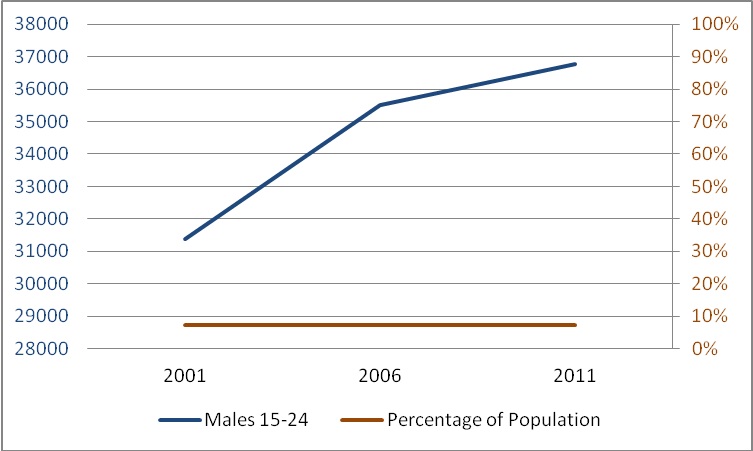
Date Source: Statistics Canada, Census (Released Every Five Years)
The Story Behind the Numbers
The number of males in Waterloo Region, aged 15 to 24, is slowly increasing. However, this increase is currently similar to the increase in the overall population in Waterloo Region. Therefore the percentage of the male population 15 to 24 is remaining steady at between 7.2% and 7.4%.
Read the Community Responses:
Posted on: September 17th, 2013 by Waterloo Region Crime Prevention Council
The length of involvement in schooling significantly impacts participation in criminal activity and the probability of incarceration. The table below tracks the percentage of residents in the Kitchener-Cambridge-Waterloo Census Metropolitan Area that do not have a high school diploma.
Data Source: Statistics Canada, Census (Released every five years)
Story Behind the Numbers
In 2006, 23.8% of residents in the Kitchener-Cambridge-Waterloo CMA did not have a high school diploma. This is the exact same as the Ontario provincial average and slightly above the Canada average of 23.4%. However, when the results are examined for individuals under the age of 35, the Waterloo Region has more residents without a high school diploma than the Provincial average. This is significant because individuals under the age of 35 are at the highest risk of participating in criminal activity.
Read the Community Responses
Posted on: September 10th, 2013 by Waterloo Region Crime Prevention Council
You might have noticed it in the title… the operative word being “early”. Every three years Senior Kindergarten teachers evaluate their students using the Early Development Instrument. This tool provides scores on a number of factors, two of which directly relate to crime prevention. Social competence measures a child’s interactions with others, ability to control their own behaviour, and cooperation with others. Emotional maturity measures a child’s ability for impulsivity control, ability to deal with feelings, and empathy for others. The percentage of children scoring low on these indices is noteworthy because antisocial behaviour among children is associated with an increased risk of persistent delinquency and criminal involvement later in life
The Statistics
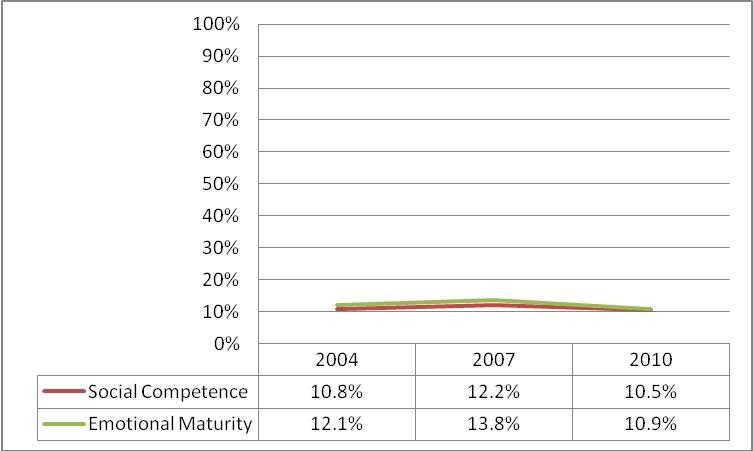 Data Source: Ontario Early Years Centre, A Community Fit for Children Report (Released Every Three Years)
Data Source: Ontario Early Years Centre, A Community Fit for Children Report (Released Every Three Years)
The Story Behind the Numbers
The percentage of children scoring low on the social competence and emotional maturity index declined from 2007 to 2010. However, despite the improvement Waterloo Region did not score as well as Ontario in 2011 which had 9.3% of children score low in social competence. Waterloo Region was also lower than Ontario, at 10.3%, on emotional maturity but this difference was not statistically significant. These numbers suggest that prevention opportunities exist through a focus on improving children’s emotional and social readiness for school.
Read the Community Responses:
Posted on: September 4th, 2013 by Waterloo Region Crime Prevention Council
Crime prevention, social capital, neighbourhood cohesion… all the stuff of Jane Jacobs and Mr. Rogers! In this latest episode of “By The Numbers” Anthony Piscitelli pays homage to a certain friendly neighbour in order to give you the highlights of a recent report from the Waterloo Region Crime Prevention Council.
You can find the full report here.
What do you think…. does your neighbourhood have a high level of social capital? Or do you live in a neighbourhood that has a high fear of crime? What does your neighbourhood do to build community and social capital?
I’d love to hear your stories!
Posted on: August 18th, 2013 by Waterloo Region Crime Prevention Council
Individuals facing homelessness are more likely to become victims of crime and/or engage in criminal activity than individuals with stable housing. If charged with a criminal offence homeless individuals are typically charged with minor property crimes and drug offences. It is fair to say that their vulnerability for victimization is of most concern in this context.
The Statistics
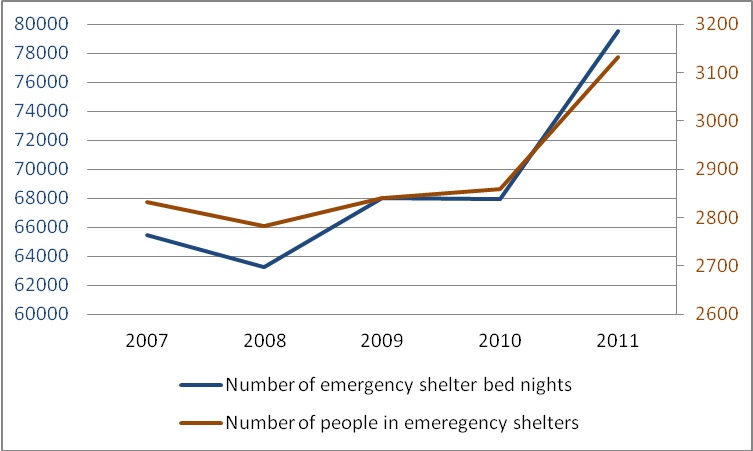
Source Data: Homelessness & Housing Umbrella Group, HHUG Report Card (Released Annually)
The Story Behind the Numbers
The number of individuals accessing emergency shelters rose 10% and the number of emergency shelter nights rose by 17% in 2011. These are significant increases after two years of relative stability. These dramatic increases are cause for concern and warrant on-going attention. Homelessness can also be seen as an extreme manifestation of poverty and form of community exclusion. These factors impact quality of life and are affecting greater numbers of people in Waterloo Region.
Read the Community Responses
Posted on: August 7th, 2013 by Waterloo Region Crime Prevention Council
Less than one quarter of victims of domestic violence report the incident to police. Collecting information from the Women’s Crisis Services of Waterloo Region provides an additional method of tracking domestic violence rates independent of police data. The chart below measures the number of women and children who received support in a Women’s Crisis Services of Waterloo Region shelter, the number of crisis calls received, and the number of women served through outreach by Women’s Crisis Services of Waterloo Region.
The Statistics
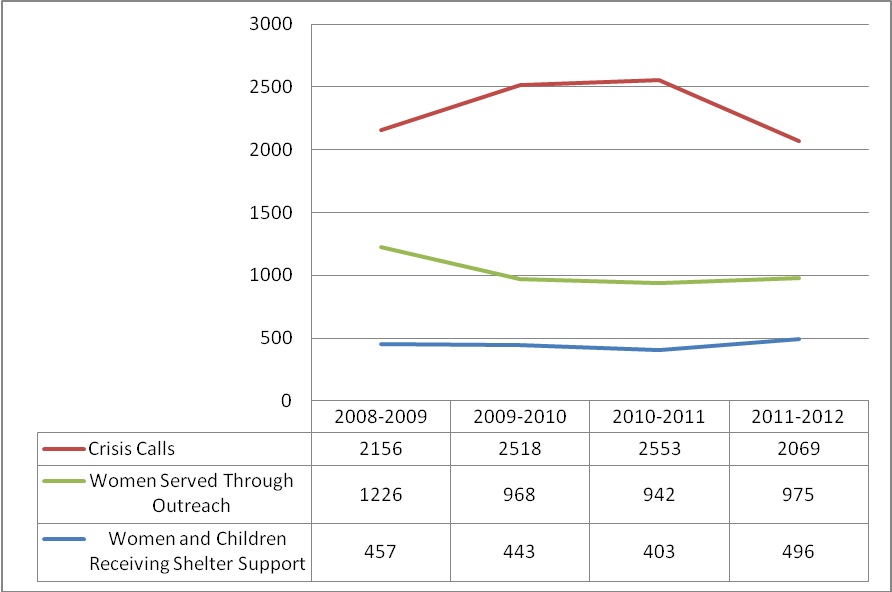 Source Data: Women’s Crisis Services of Waterloo Region, Annual Report
Source Data: Women’s Crisis Services of Waterloo Region, Annual Report
The Story Behind the Numbers
The crisis calls for support recently dropped. The number of women served through outreach appears to be relatively stable over the past three years. In the past year the number of women and children living in shelters increased dramatically. This increase is believed to be associated with the opening of the new site for the shelter. The opening generated publicity and improved living conditions for women in the shelter which is believed to have made women more comfortable seeking service.
Read the Community Responses
Posted on: July 24th, 2013 by Waterloo Region Crime Prevention Council
A 2010 report, “People Without Jobs. Jobs Without People”, highlights concerning trends in the Ontario labour market; noting that we will have both a labour and skills storage by 2031. It also highlights the increased levels of unemployment experienced by the province in the wake of the 2008 recession.
But Waterloo Region’s unemployment rate is improving, right? The information presented in “A Snapshot in Time: The Root Causes of Crime in Waterloo Region” indeed shows the improvement we are observing in Waterloo Region’s labour market (p.9). However, the overall unemployment rate masks some concerning trends for specific segments of our workforce. Unemployment for youth, new Canadians, displaced manufacturing workers, and older workers has remained high despite the overall improvement in local economic conditions.
These structural changes present real challenges to the economic and social challenges our community will face over the next twenty years, including:
- Youth that experience delays in starting careers, and the associated reduction in potential lifetime earnings. As well as the pressure many employers will face when there are insufficient qualified people to fill roles as baby boomers retire.
- New Canadians that migrate to Ontario with professional educations and experiences, who are unable to find work commensurate with their qualifications. As well as employers that cannot access the diverse skilled labour needed to make their businesses globally competitive.
- Displaced manufacturing workers that have not been afforded the continuous learning opportunities in previous jobs and find their skills out-of-date. As well as employers that cannot access their maturity, experience, and transferable skills.
- Experienced Workers (those who are 55+) that find themselves without the skills to compete with a new highly educated workforce and find retirement savings in jeopardy, as well as employers that lose access to candidates that still have ten years of work left, and maturity and skill to mentor the next generation of worker.
As can be seen, these structural changes present potential long term impacts on our local economy and social support structures. With these new challenges come the potential to see increased: poverty, mental health challenges, heath impacts, and as outlined in “The Root Causes of Crime in Waterloo” – an increase in crime.
While these challenges can seem overwhelming, there are many local organizations implementing innovative ways of addressing these employment challenges. The following programs are examples of the specific programs Lutherwood has been working with in Waterloo Region and Guelph:
- Transitioning In New Times: Funded by the Ontario Trillium Foundation, Lutherwood has been operating a demand-side focused employment program. The intent of the program is to more effectively bridge the gap between people experiencing increased unemployment and employers struggling to find qualified candidates for open positions. The program develops training to address specific industry needs, and work to support candidates into these roles. The program has seen meaningful success, and there are provincial replication efforts underway.
- Mentorship for Internationally Trained Professionals: Recently Lutherwood began a Mentorship program for Internally Trained Professionals in the Guelph area, a similar program is run by the YMCA in Waterloo Region. The intent of the program is to connect professional newcomers with mentors in their field of expertise, giving them connection to establish themselves in careers commensurate with their education and experience. A recent Maytree Foundation report shows that mentorship significantly increases entry into professional careers for new comers.
- Targeted Initiative for Older Workers (TIOW): Through this program for experienced workers (those that are older than 55) individuals get employment skill development, skills upgrading, employment coaching, and structured work placements. Through this targeted program these workers are able to upgrade and refresh bring valuable experience, maturity, and skill to employers.
While each of these programs takes a different approach to addressing persistent unemployment in our community, one thing is constant; the intervention is scoped to the needs of the population being served. This approach ensures the effectiveness of the program to address specific needs. Over the next several years it will be important that we continue to seek new approaches to address unemployment being experienced by youth, experienced workers, new Canadians, and those displaced from the manufacturing sector. These approaches should be targeted to the populations being served, should engage each level of government and most importantly engage area employers.
Author: Aaron Stauch is a Program Manager at Lutherwood with experience in both the employment and mental health sectors.
Read also:
Posted on: July 23rd, 2013 by Waterloo Region Crime Prevention Council
Over the next ten weeks stay tuned here to the blog discussion on The Root Causes of Crime in Waterloo Region where community leaders, community residents and leading experts across Waterloo Region weigh in on the root causes of crime outlined in the report.
Unemployment Rates & the Relationship to Crime
The relationship between unemployment and property crime is well established in academic literature. Generally a 1% drop in unemployment rates leads to approximately a 1% drop in property crime. The impact on property crime rates is believed to be more pronounced when unemployment is high for male youth. Violent crime and unemployment on their own tend to be unrelated. However, when high levels of unemployment are combined with high levels of alcohol consumption it is believed to cause an increase in the homicide rate.
The Statistics
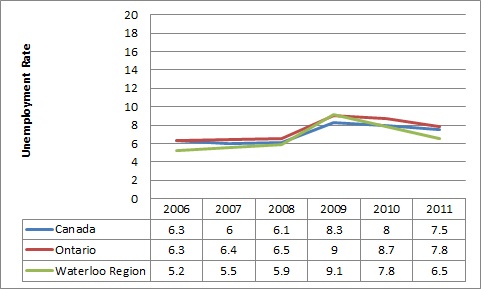
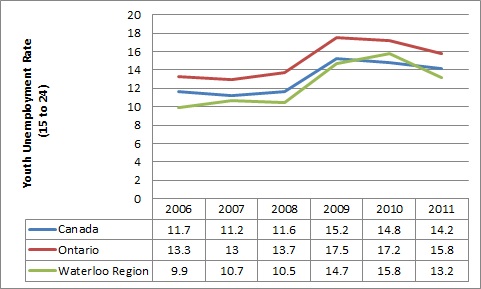 Source Data: Statistics Canada, Labour Force Survey: CANSIM Table 1095304 (Released Annually)
Source Data: Statistics Canada, Labour Force Survey: CANSIM Table 1095304 (Released Annually)
The Story Behind the Numbers
The 2011 decrease in unemployment in the Kitchener-Cambridge-Waterloo CMA echoes a trend that was seen in the rest of Canada.The decrease in unemployment is directly related to a slowly rebounding economy.Youth unemployment improved in 2011 but not to the same degree as unemployment generally.High youth unemployment combined with a growing male population raises some concerns for the local crime rate.
Read the Community Responses
 Author: Sara Casselman is the Public Relations & Operations Manager at the Sexual Assault Support Centre of Waterloo Region. In the anti-violence against women sector for more than a decade, Sara has been recognized provincially as a Leading Women, Building Communities Award Recipient (2011) and was featured in The Record’s 40 under 40 (2012).
Author: Sara Casselman is the Public Relations & Operations Manager at the Sexual Assault Support Centre of Waterloo Region. In the anti-violence against women sector for more than a decade, Sara has been recognized provincially as a Leading Women, Building Communities Award Recipient (2011) and was featured in The Record’s 40 under 40 (2012).


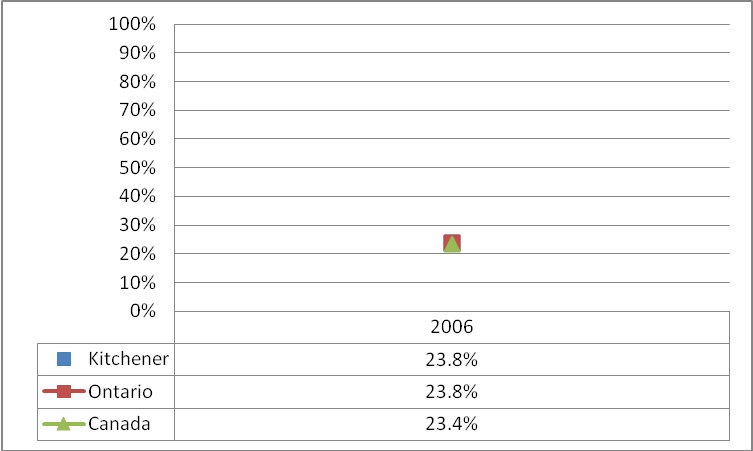
 Data Source: Ontario Early Years Centre, A Community Fit for Children Report (Released Every Three Years)
Data Source: Ontario Early Years Centre, A Community Fit for Children Report (Released Every Three Years)
 Source Data: Women’s Crisis Services of Waterloo Region, Annual Report
Source Data: Women’s Crisis Services of Waterloo Region, Annual Report
 Source Data: Statistics Canada, Labour Force Survey: CANSIM Table 1095304 (Released Annually)
Source Data: Statistics Canada, Labour Force Survey: CANSIM Table 1095304 (Released Annually)